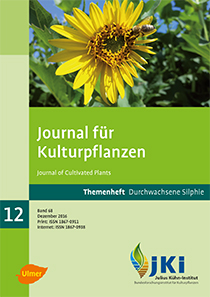Agro-ecological potential of the cup plant (Silphium perfoliatum L.) from a biodiversity perspective
Keywords:
Pollinators, soil fauna, landscape context, functional biodiversityAbstract
The cup plant (Silphium perfoliatum L.) is an alternative bioenergy plant that may contribute to a more environmentally friendly utilization of renewable resources. The potential benefits of the cup plant comprise its flowering-characteristics and the perennial cultivation without tillage. Hence organisms could be fostered that serve important ecosystem-functions, i.e. pollination and soil fertility.
To date biomass production in Germany is based on cropping systems that bear a risk for biodiversity and ecosystem-services. The importance to counteract this development becomes more pronounced, considering the land requirements for significant generation of energy from biomass.
To what extent cropping of the cup plant meets the expectations of a sustainable biomass production was investigated within a comprehensive assessment of pollinating insects (bees and hoverflies) including pollen- and nectar-quantification as well as of soil-fauna communities (earthworms, collembolans, nematodes) and according functional groups in cup-plant stands with a commercial orientation of management.
From the results it became obvious that the cup plant as a bioenergy crop has got the necessary potential to mitigate the negative development of biodiversity and ecosystem services, especially in regions with a large share of maize monocultures. This agro-ecological potential can only be exploited if certain agronomic requirements are met, i.e. a late harvest and cultivation periods of at least five years. Under these conditions the landscape context has to be considered. Semi-natural habitats are required for nesting and larval development of wild pollinator-groups, whereas positive development of biological functions in soil is tied to the land-use history.
DOI: 10.1399/JfK.2016.12.12, https://doi.org/10.1399/JfK.2016.12.12








